Organisational Behaviour Report: Apple and IBM Analysis
VerifiedAdded on 2023/01/11
|19
|7154
|56
Report
AI Summary
This report provides a detailed analysis of organizational behavior, focusing on two major companies: Apple and IBM. It begins by examining how organizational culture, politics, and power influence individual and team behavior and performance within Apple. The report then explores various motivational theories, including content and process theories, and how these theories are applied to enhance employee motivation and achieve organizational goals. Furthermore, it delves into team development theories and their application within IBM, highlighting the concepts of effective and ineffective teams and strategies for fostering dynamic cooperation. The report also discusses the concepts and philosophies of organizational behavior, examining their impact on behavior in both positive and negative ways. Finally, it includes recommendations for improving team success by integrating culture, power, politics, and motivation. The report uses various theories to explain the concepts of organizational behaviour.
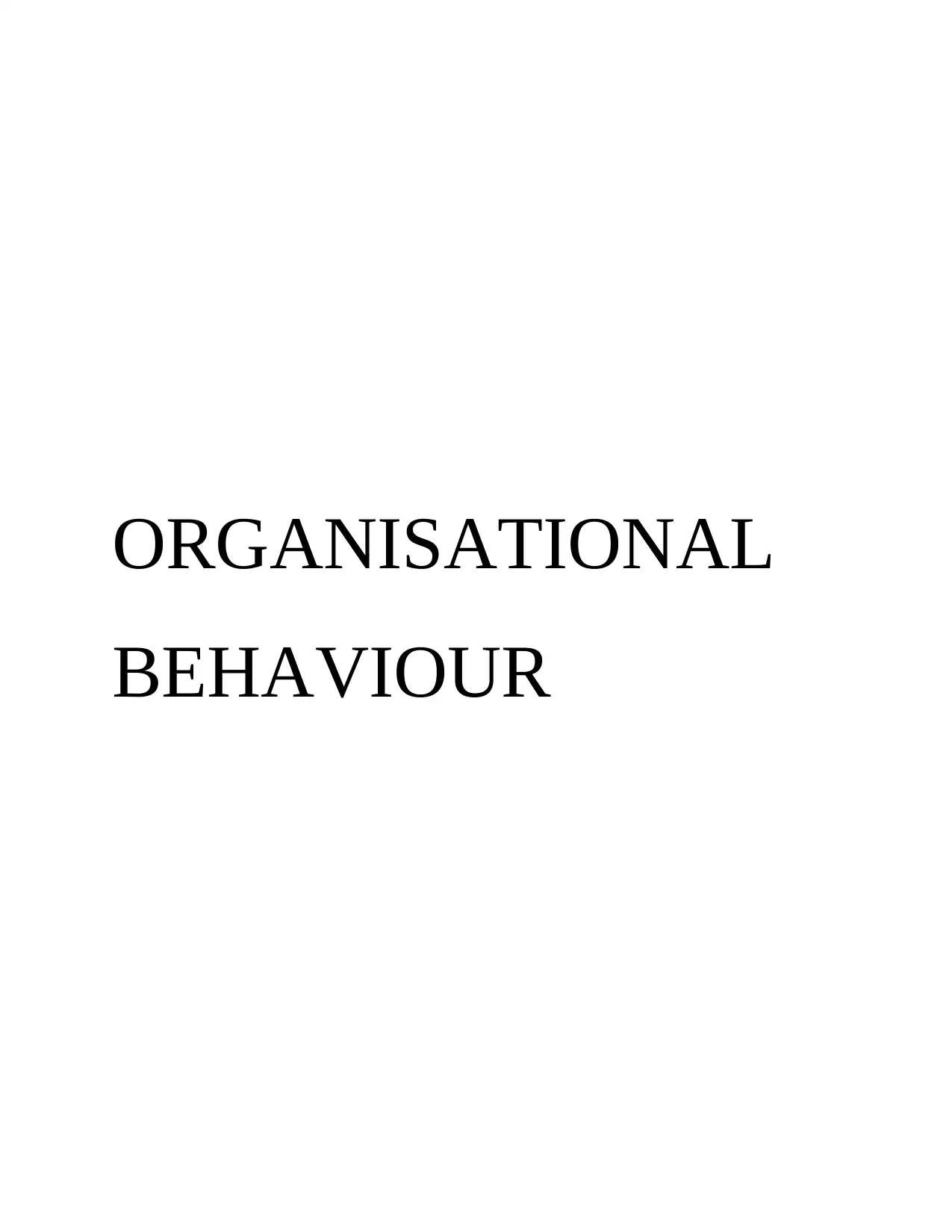
ORGANISATIONAL
BEHAVIOUR
BEHAVIOUR
Paraphrase This Document
Need a fresh take? Get an instant paraphrase of this document with our AI Paraphraser
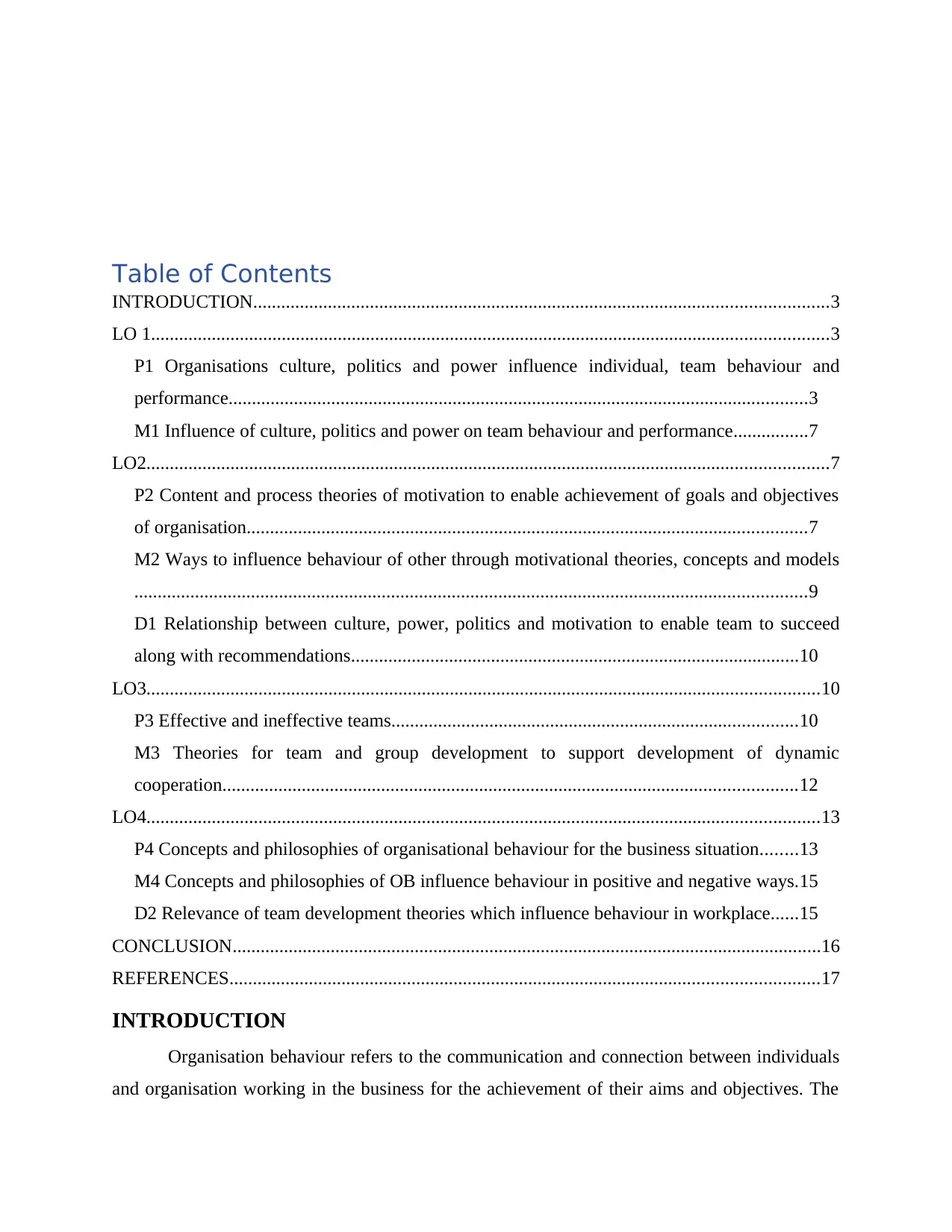
Table of Contents
INTRODUCTION...........................................................................................................................3
LO 1.................................................................................................................................................3
P1 Organisations culture, politics and power influence individual, team behaviour and
performance............................................................................................................................3
M1 Influence of culture, politics and power on team behaviour and performance................7
LO2..................................................................................................................................................7
P2 Content and process theories of motivation to enable achievement of goals and objectives
of organisation........................................................................................................................7
M2 Ways to influence behaviour of other through motivational theories, concepts and models
................................................................................................................................................9
D1 Relationship between culture, power, politics and motivation to enable team to succeed
along with recommendations................................................................................................10
LO3................................................................................................................................................10
P3 Effective and ineffective teams.......................................................................................10
M3 Theories for team and group development to support development of dynamic
cooperation...........................................................................................................................12
LO4................................................................................................................................................13
P4 Concepts and philosophies of organisational behaviour for the business situation........13
M4 Concepts and philosophies of OB influence behaviour in positive and negative ways.15
D2 Relevance of team development theories which influence behaviour in workplace......15
CONCLUSION..............................................................................................................................16
REFERENCES..............................................................................................................................17
INTRODUCTION
Organisation behaviour refers to the communication and connection between individuals
and organisation working in the business for the achievement of their aims and objectives. The
INTRODUCTION...........................................................................................................................3
LO 1.................................................................................................................................................3
P1 Organisations culture, politics and power influence individual, team behaviour and
performance............................................................................................................................3
M1 Influence of culture, politics and power on team behaviour and performance................7
LO2..................................................................................................................................................7
P2 Content and process theories of motivation to enable achievement of goals and objectives
of organisation........................................................................................................................7
M2 Ways to influence behaviour of other through motivational theories, concepts and models
................................................................................................................................................9
D1 Relationship between culture, power, politics and motivation to enable team to succeed
along with recommendations................................................................................................10
LO3................................................................................................................................................10
P3 Effective and ineffective teams.......................................................................................10
M3 Theories for team and group development to support development of dynamic
cooperation...........................................................................................................................12
LO4................................................................................................................................................13
P4 Concepts and philosophies of organisational behaviour for the business situation........13
M4 Concepts and philosophies of OB influence behaviour in positive and negative ways.15
D2 Relevance of team development theories which influence behaviour in workplace......15
CONCLUSION..............................................................................................................................16
REFERENCES..............................................................................................................................17
INTRODUCTION
Organisation behaviour refers to the communication and connection between individuals
and organisation working in the business for the achievement of their aims and objectives. The
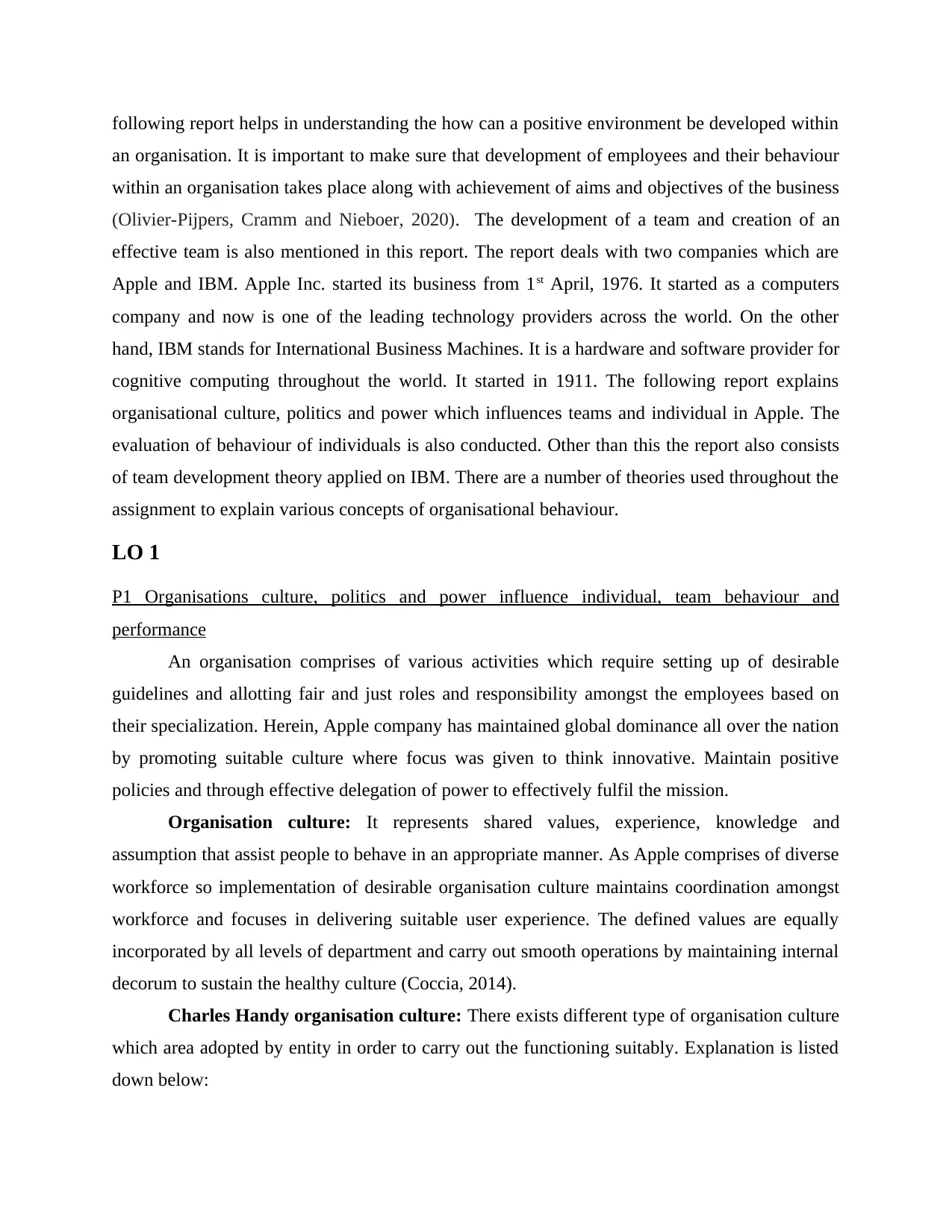
following report helps in understanding the how can a positive environment be developed within
an organisation. It is important to make sure that development of employees and their behaviour
within an organisation takes place along with achievement of aims and objectives of the business
(Olivier-Pijpers, Cramm and Nieboer, 2020). The development of a team and creation of an
effective team is also mentioned in this report. The report deals with two companies which are
Apple and IBM. Apple Inc. started its business from 1st April, 1976. It started as a computers
company and now is one of the leading technology providers across the world. On the other
hand, IBM stands for International Business Machines. It is a hardware and software provider for
cognitive computing throughout the world. It started in 1911. The following report explains
organisational culture, politics and power which influences teams and individual in Apple. The
evaluation of behaviour of individuals is also conducted. Other than this the report also consists
of team development theory applied on IBM. There are a number of theories used throughout the
assignment to explain various concepts of organisational behaviour.
LO 1
P1 Organisations culture, politics and power influence individual, team behaviour and
performance
An organisation comprises of various activities which require setting up of desirable
guidelines and allotting fair and just roles and responsibility amongst the employees based on
their specialization. Herein, Apple company has maintained global dominance all over the nation
by promoting suitable culture where focus was given to think innovative. Maintain positive
policies and through effective delegation of power to effectively fulfil the mission.
Organisation culture: It represents shared values, experience, knowledge and
assumption that assist people to behave in an appropriate manner. As Apple comprises of diverse
workforce so implementation of desirable organisation culture maintains coordination amongst
workforce and focuses in delivering suitable user experience. The defined values are equally
incorporated by all levels of department and carry out smooth operations by maintaining internal
decorum to sustain the healthy culture (Coccia, 2014).
Charles Handy organisation culture: There exists different type of organisation culture
which area adopted by entity in order to carry out the functioning suitably. Explanation is listed
down below:
an organisation. It is important to make sure that development of employees and their behaviour
within an organisation takes place along with achievement of aims and objectives of the business
(Olivier-Pijpers, Cramm and Nieboer, 2020). The development of a team and creation of an
effective team is also mentioned in this report. The report deals with two companies which are
Apple and IBM. Apple Inc. started its business from 1st April, 1976. It started as a computers
company and now is one of the leading technology providers across the world. On the other
hand, IBM stands for International Business Machines. It is a hardware and software provider for
cognitive computing throughout the world. It started in 1911. The following report explains
organisational culture, politics and power which influences teams and individual in Apple. The
evaluation of behaviour of individuals is also conducted. Other than this the report also consists
of team development theory applied on IBM. There are a number of theories used throughout the
assignment to explain various concepts of organisational behaviour.
LO 1
P1 Organisations culture, politics and power influence individual, team behaviour and
performance
An organisation comprises of various activities which require setting up of desirable
guidelines and allotting fair and just roles and responsibility amongst the employees based on
their specialization. Herein, Apple company has maintained global dominance all over the nation
by promoting suitable culture where focus was given to think innovative. Maintain positive
policies and through effective delegation of power to effectively fulfil the mission.
Organisation culture: It represents shared values, experience, knowledge and
assumption that assist people to behave in an appropriate manner. As Apple comprises of diverse
workforce so implementation of desirable organisation culture maintains coordination amongst
workforce and focuses in delivering suitable user experience. The defined values are equally
incorporated by all levels of department and carry out smooth operations by maintaining internal
decorum to sustain the healthy culture (Coccia, 2014).
Charles Handy organisation culture: There exists different type of organisation culture
which area adopted by entity in order to carry out the functioning suitably. Explanation is listed
down below:
⊘ This is a preview!⊘
Do you want full access?
Subscribe today to unlock all pages.

Trusted by 1+ million students worldwide
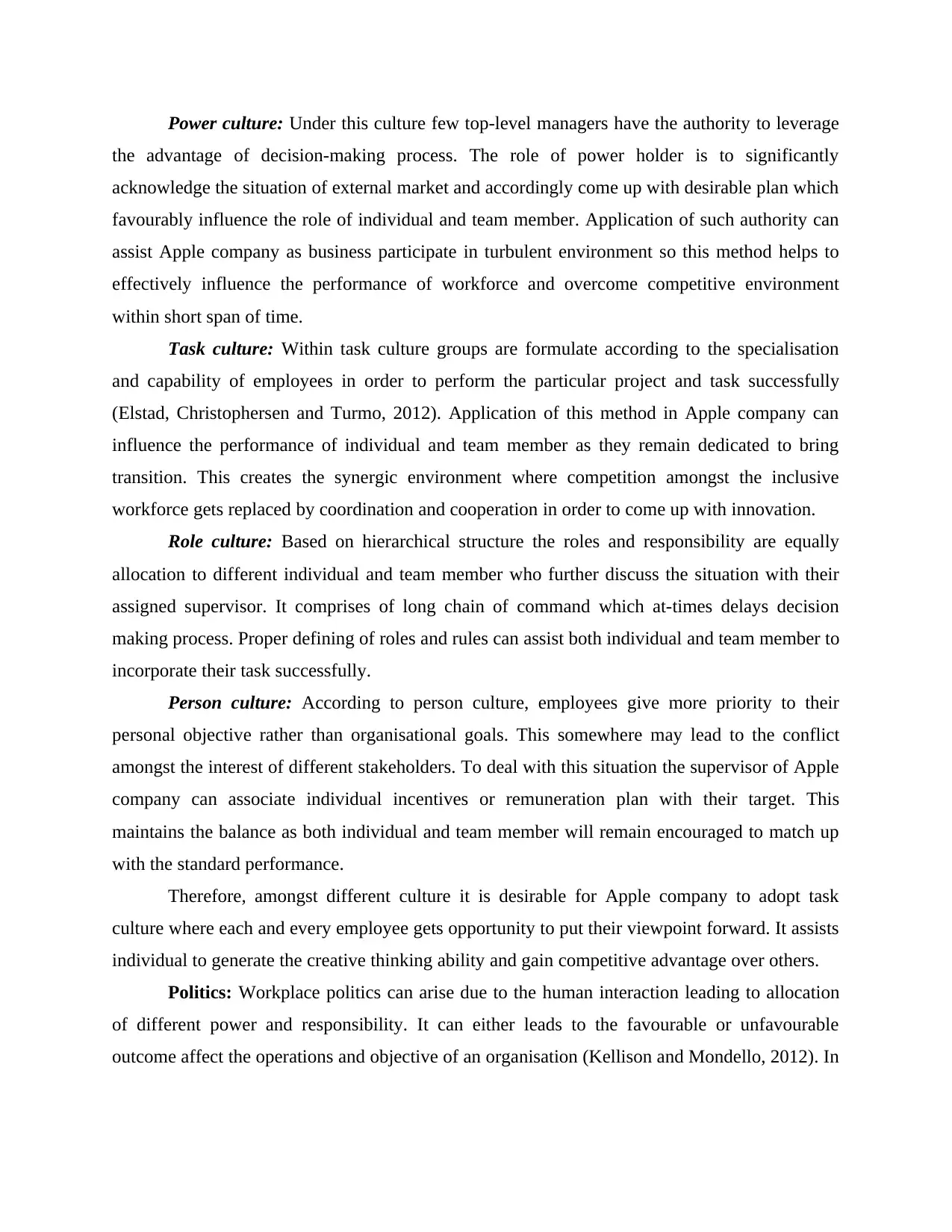
Power culture: Under this culture few top-level managers have the authority to leverage
the advantage of decision-making process. The role of power holder is to significantly
acknowledge the situation of external market and accordingly come up with desirable plan which
favourably influence the role of individual and team member. Application of such authority can
assist Apple company as business participate in turbulent environment so this method helps to
effectively influence the performance of workforce and overcome competitive environment
within short span of time.
Task culture: Within task culture groups are formulate according to the specialisation
and capability of employees in order to perform the particular project and task successfully
(Elstad, Christophersen and Turmo, 2012). Application of this method in Apple company can
influence the performance of individual and team member as they remain dedicated to bring
transition. This creates the synergic environment where competition amongst the inclusive
workforce gets replaced by coordination and cooperation in order to come up with innovation.
Role culture: Based on hierarchical structure the roles and responsibility are equally
allocation to different individual and team member who further discuss the situation with their
assigned supervisor. It comprises of long chain of command which at-times delays decision
making process. Proper defining of roles and rules can assist both individual and team member to
incorporate their task successfully.
Person culture: According to person culture, employees give more priority to their
personal objective rather than organisational goals. This somewhere may lead to the conflict
amongst the interest of different stakeholders. To deal with this situation the supervisor of Apple
company can associate individual incentives or remuneration plan with their target. This
maintains the balance as both individual and team member will remain encouraged to match up
with the standard performance.
Therefore, amongst different culture it is desirable for Apple company to adopt task
culture where each and every employee gets opportunity to put their viewpoint forward. It assists
individual to generate the creative thinking ability and gain competitive advantage over others.
Politics: Workplace politics can arise due to the human interaction leading to allocation
of different power and responsibility. It can either leads to the favourable or unfavourable
outcome affect the operations and objective of an organisation (Kellison and Mondello, 2012). In
the advantage of decision-making process. The role of power holder is to significantly
acknowledge the situation of external market and accordingly come up with desirable plan which
favourably influence the role of individual and team member. Application of such authority can
assist Apple company as business participate in turbulent environment so this method helps to
effectively influence the performance of workforce and overcome competitive environment
within short span of time.
Task culture: Within task culture groups are formulate according to the specialisation
and capability of employees in order to perform the particular project and task successfully
(Elstad, Christophersen and Turmo, 2012). Application of this method in Apple company can
influence the performance of individual and team member as they remain dedicated to bring
transition. This creates the synergic environment where competition amongst the inclusive
workforce gets replaced by coordination and cooperation in order to come up with innovation.
Role culture: Based on hierarchical structure the roles and responsibility are equally
allocation to different individual and team member who further discuss the situation with their
assigned supervisor. It comprises of long chain of command which at-times delays decision
making process. Proper defining of roles and rules can assist both individual and team member to
incorporate their task successfully.
Person culture: According to person culture, employees give more priority to their
personal objective rather than organisational goals. This somewhere may lead to the conflict
amongst the interest of different stakeholders. To deal with this situation the supervisor of Apple
company can associate individual incentives or remuneration plan with their target. This
maintains the balance as both individual and team member will remain encouraged to match up
with the standard performance.
Therefore, amongst different culture it is desirable for Apple company to adopt task
culture where each and every employee gets opportunity to put their viewpoint forward. It assists
individual to generate the creative thinking ability and gain competitive advantage over others.
Politics: Workplace politics can arise due to the human interaction leading to allocation
of different power and responsibility. It can either leads to the favourable or unfavourable
outcome affect the operations and objective of an organisation (Kellison and Mondello, 2012). In
Paraphrase This Document
Need a fresh take? Get an instant paraphrase of this document with our AI Paraphraser
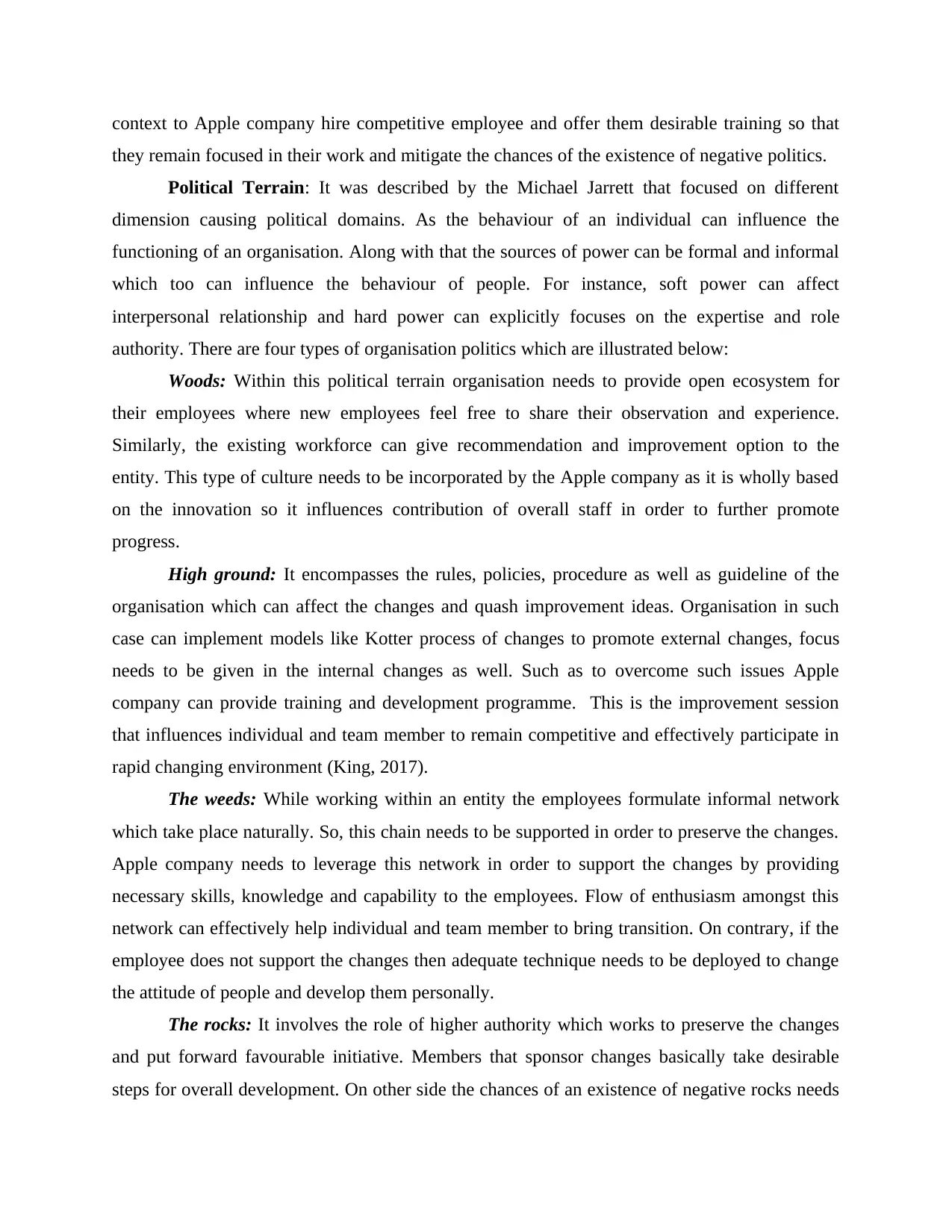
context to Apple company hire competitive employee and offer them desirable training so that
they remain focused in their work and mitigate the chances of the existence of negative politics.
Political Terrain: It was described by the Michael Jarrett that focused on different
dimension causing political domains. As the behaviour of an individual can influence the
functioning of an organisation. Along with that the sources of power can be formal and informal
which too can influence the behaviour of people. For instance, soft power can affect
interpersonal relationship and hard power can explicitly focuses on the expertise and role
authority. There are four types of organisation politics which are illustrated below:
Woods: Within this political terrain organisation needs to provide open ecosystem for
their employees where new employees feel free to share their observation and experience.
Similarly, the existing workforce can give recommendation and improvement option to the
entity. This type of culture needs to be incorporated by the Apple company as it is wholly based
on the innovation so it influences contribution of overall staff in order to further promote
progress.
High ground: It encompasses the rules, policies, procedure as well as guideline of the
organisation which can affect the changes and quash improvement ideas. Organisation in such
case can implement models like Kotter process of changes to promote external changes, focus
needs to be given in the internal changes as well. Such as to overcome such issues Apple
company can provide training and development programme. This is the improvement session
that influences individual and team member to remain competitive and effectively participate in
rapid changing environment (King, 2017).
The weeds: While working within an entity the employees formulate informal network
which take place naturally. So, this chain needs to be supported in order to preserve the changes.
Apple company needs to leverage this network in order to support the changes by providing
necessary skills, knowledge and capability to the employees. Flow of enthusiasm amongst this
network can effectively help individual and team member to bring transition. On contrary, if the
employee does not support the changes then adequate technique needs to be deployed to change
the attitude of people and develop them personally.
The rocks: It involves the role of higher authority which works to preserve the changes
and put forward favourable initiative. Members that sponsor changes basically take desirable
steps for overall development. On other side the chances of an existence of negative rocks needs
they remain focused in their work and mitigate the chances of the existence of negative politics.
Political Terrain: It was described by the Michael Jarrett that focused on different
dimension causing political domains. As the behaviour of an individual can influence the
functioning of an organisation. Along with that the sources of power can be formal and informal
which too can influence the behaviour of people. For instance, soft power can affect
interpersonal relationship and hard power can explicitly focuses on the expertise and role
authority. There are four types of organisation politics which are illustrated below:
Woods: Within this political terrain organisation needs to provide open ecosystem for
their employees where new employees feel free to share their observation and experience.
Similarly, the existing workforce can give recommendation and improvement option to the
entity. This type of culture needs to be incorporated by the Apple company as it is wholly based
on the innovation so it influences contribution of overall staff in order to further promote
progress.
High ground: It encompasses the rules, policies, procedure as well as guideline of the
organisation which can affect the changes and quash improvement ideas. Organisation in such
case can implement models like Kotter process of changes to promote external changes, focus
needs to be given in the internal changes as well. Such as to overcome such issues Apple
company can provide training and development programme. This is the improvement session
that influences individual and team member to remain competitive and effectively participate in
rapid changing environment (King, 2017).
The weeds: While working within an entity the employees formulate informal network
which take place naturally. So, this chain needs to be supported in order to preserve the changes.
Apple company needs to leverage this network in order to support the changes by providing
necessary skills, knowledge and capability to the employees. Flow of enthusiasm amongst this
network can effectively help individual and team member to bring transition. On contrary, if the
employee does not support the changes then adequate technique needs to be deployed to change
the attitude of people and develop them personally.
The rocks: It involves the role of higher authority which works to preserve the changes
and put forward favourable initiative. Members that sponsor changes basically take desirable
steps for overall development. On other side the chances of an existence of negative rocks needs
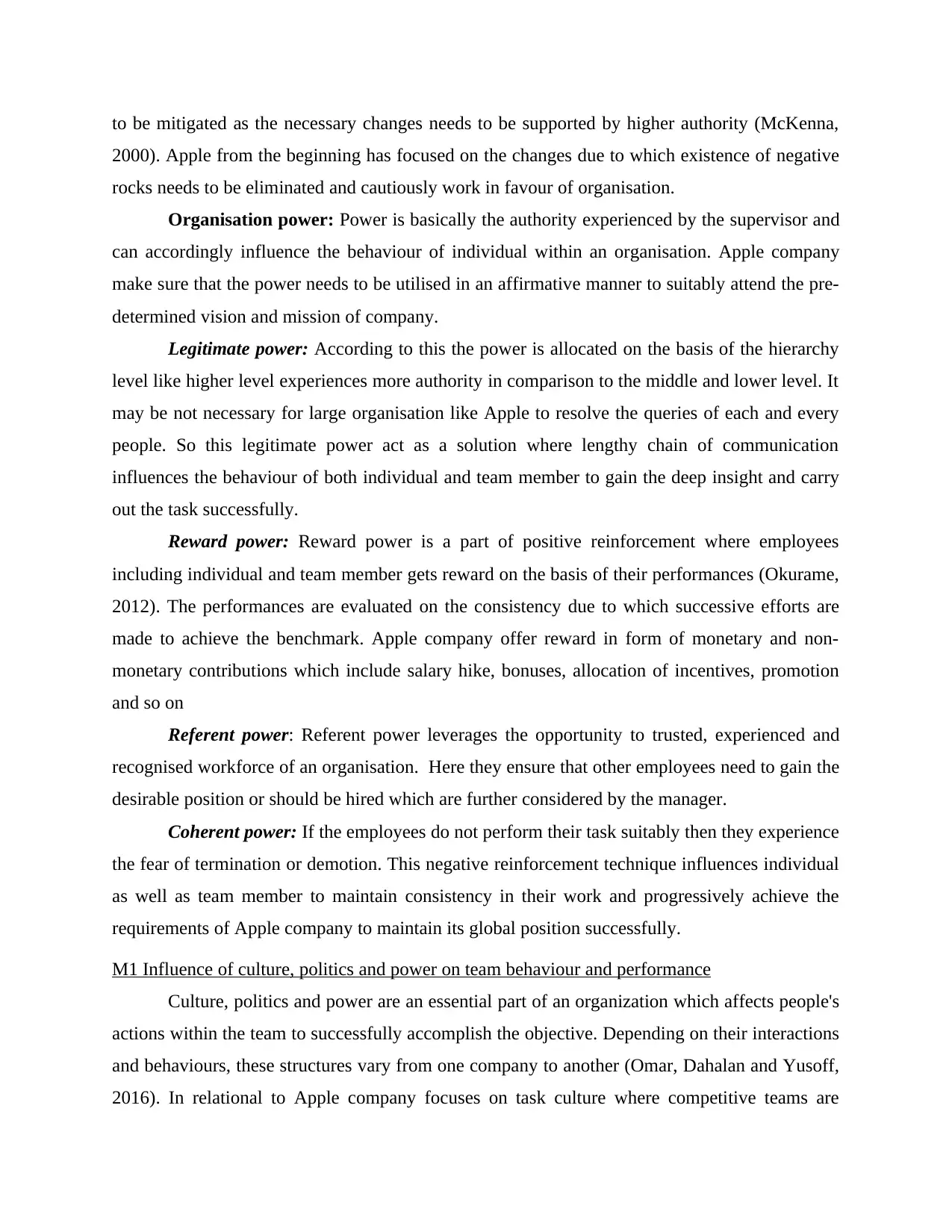
to be mitigated as the necessary changes needs to be supported by higher authority (McKenna,
2000). Apple from the beginning has focused on the changes due to which existence of negative
rocks needs to be eliminated and cautiously work in favour of organisation.
Organisation power: Power is basically the authority experienced by the supervisor and
can accordingly influence the behaviour of individual within an organisation. Apple company
make sure that the power needs to be utilised in an affirmative manner to suitably attend the pre-
determined vision and mission of company.
Legitimate power: According to this the power is allocated on the basis of the hierarchy
level like higher level experiences more authority in comparison to the middle and lower level. It
may be not necessary for large organisation like Apple to resolve the queries of each and every
people. So this legitimate power act as a solution where lengthy chain of communication
influences the behaviour of both individual and team member to gain the deep insight and carry
out the task successfully.
Reward power: Reward power is a part of positive reinforcement where employees
including individual and team member gets reward on the basis of their performances (Okurame,
2012). The performances are evaluated on the consistency due to which successive efforts are
made to achieve the benchmark. Apple company offer reward in form of monetary and non-
monetary contributions which include salary hike, bonuses, allocation of incentives, promotion
and so on
Referent power: Referent power leverages the opportunity to trusted, experienced and
recognised workforce of an organisation. Here they ensure that other employees need to gain the
desirable position or should be hired which are further considered by the manager.
Coherent power: If the employees do not perform their task suitably then they experience
the fear of termination or demotion. This negative reinforcement technique influences individual
as well as team member to maintain consistency in their work and progressively achieve the
requirements of Apple company to maintain its global position successfully.
M1 Influence of culture, politics and power on team behaviour and performance
Culture, politics and power are an essential part of an organization which affects people's
actions within the team to successfully accomplish the objective. Depending on their interactions
and behaviours, these structures vary from one company to another (Omar, Dahalan and Yusoff,
2016). In relational to Apple company focuses on task culture where competitive teams are
2000). Apple from the beginning has focused on the changes due to which existence of negative
rocks needs to be eliminated and cautiously work in favour of organisation.
Organisation power: Power is basically the authority experienced by the supervisor and
can accordingly influence the behaviour of individual within an organisation. Apple company
make sure that the power needs to be utilised in an affirmative manner to suitably attend the pre-
determined vision and mission of company.
Legitimate power: According to this the power is allocated on the basis of the hierarchy
level like higher level experiences more authority in comparison to the middle and lower level. It
may be not necessary for large organisation like Apple to resolve the queries of each and every
people. So this legitimate power act as a solution where lengthy chain of communication
influences the behaviour of both individual and team member to gain the deep insight and carry
out the task successfully.
Reward power: Reward power is a part of positive reinforcement where employees
including individual and team member gets reward on the basis of their performances (Okurame,
2012). The performances are evaluated on the consistency due to which successive efforts are
made to achieve the benchmark. Apple company offer reward in form of monetary and non-
monetary contributions which include salary hike, bonuses, allocation of incentives, promotion
and so on
Referent power: Referent power leverages the opportunity to trusted, experienced and
recognised workforce of an organisation. Here they ensure that other employees need to gain the
desirable position or should be hired which are further considered by the manager.
Coherent power: If the employees do not perform their task suitably then they experience
the fear of termination or demotion. This negative reinforcement technique influences individual
as well as team member to maintain consistency in their work and progressively achieve the
requirements of Apple company to maintain its global position successfully.
M1 Influence of culture, politics and power on team behaviour and performance
Culture, politics and power are an essential part of an organization which affects people's
actions within the team to successfully accomplish the objective. Depending on their interactions
and behaviours, these structures vary from one company to another (Omar, Dahalan and Yusoff,
2016). In relational to Apple company focuses on task culture where competitive teams are
⊘ This is a preview!⊘
Do you want full access?
Subscribe today to unlock all pages.

Trusted by 1+ million students worldwide
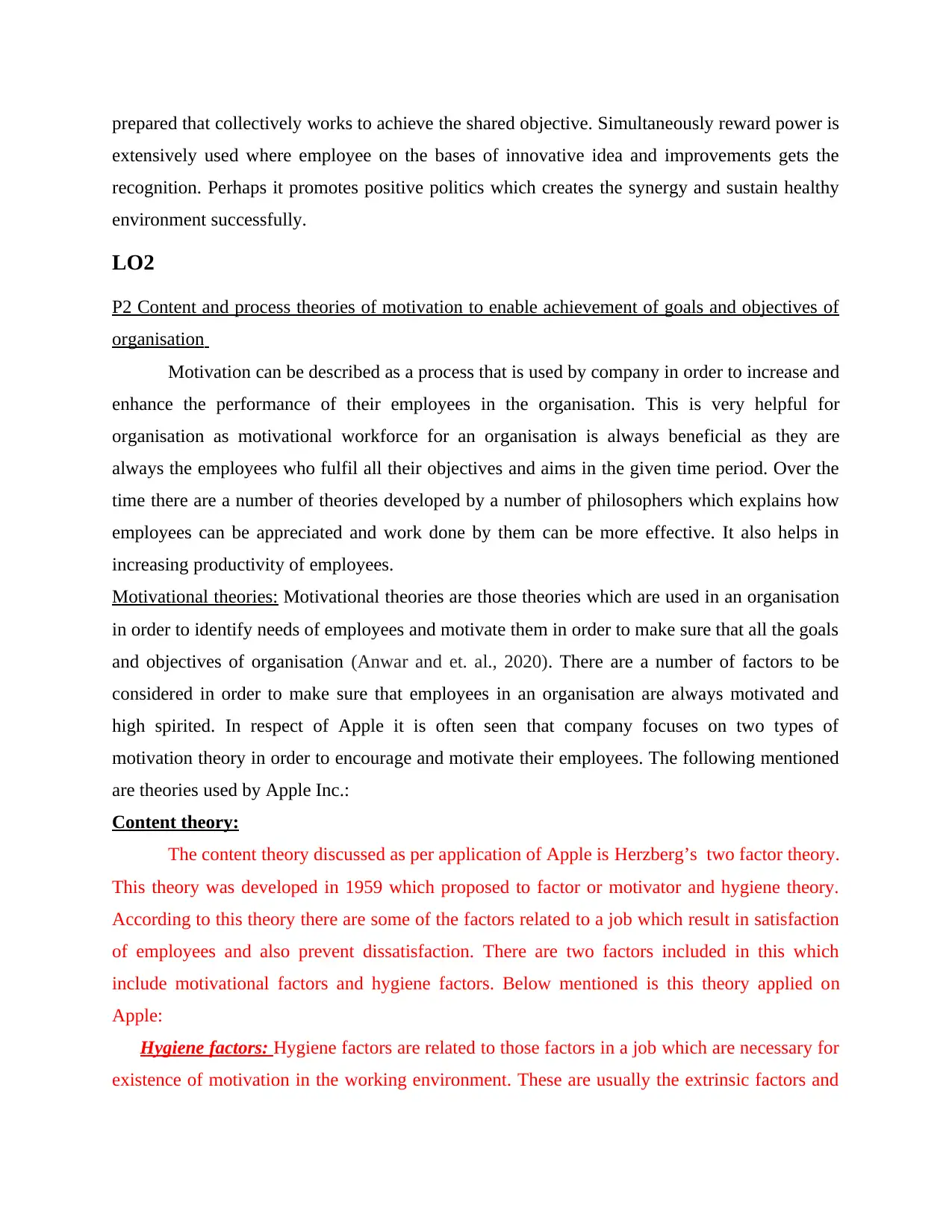
prepared that collectively works to achieve the shared objective. Simultaneously reward power is
extensively used where employee on the bases of innovative idea and improvements gets the
recognition. Perhaps it promotes positive politics which creates the synergy and sustain healthy
environment successfully.
LO2
P2 Content and process theories of motivation to enable achievement of goals and objectives of
organisation
Motivation can be described as a process that is used by company in order to increase and
enhance the performance of their employees in the organisation. This is very helpful for
organisation as motivational workforce for an organisation is always beneficial as they are
always the employees who fulfil all their objectives and aims in the given time period. Over the
time there are a number of theories developed by a number of philosophers which explains how
employees can be appreciated and work done by them can be more effective. It also helps in
increasing productivity of employees.
Motivational theories: Motivational theories are those theories which are used in an organisation
in order to identify needs of employees and motivate them in order to make sure that all the goals
and objectives of organisation (Anwar and et. al., 2020). There are a number of factors to be
considered in order to make sure that employees in an organisation are always motivated and
high spirited. In respect of Apple it is often seen that company focuses on two types of
motivation theory in order to encourage and motivate their employees. The following mentioned
are theories used by Apple Inc.:
Content theory:
The content theory discussed as per application of Apple is Herzberg’s two factor theory.
This theory was developed in 1959 which proposed to factor or motivator and hygiene theory.
According to this theory there are some of the factors related to a job which result in satisfaction
of employees and also prevent dissatisfaction. There are two factors included in this which
include motivational factors and hygiene factors. Below mentioned is this theory applied on
Apple:
Hygiene factors: Hygiene factors are related to those factors in a job which are necessary for
existence of motivation in the working environment. These are usually the extrinsic factors and
extensively used where employee on the bases of innovative idea and improvements gets the
recognition. Perhaps it promotes positive politics which creates the synergy and sustain healthy
environment successfully.
LO2
P2 Content and process theories of motivation to enable achievement of goals and objectives of
organisation
Motivation can be described as a process that is used by company in order to increase and
enhance the performance of their employees in the organisation. This is very helpful for
organisation as motivational workforce for an organisation is always beneficial as they are
always the employees who fulfil all their objectives and aims in the given time period. Over the
time there are a number of theories developed by a number of philosophers which explains how
employees can be appreciated and work done by them can be more effective. It also helps in
increasing productivity of employees.
Motivational theories: Motivational theories are those theories which are used in an organisation
in order to identify needs of employees and motivate them in order to make sure that all the goals
and objectives of organisation (Anwar and et. al., 2020). There are a number of factors to be
considered in order to make sure that employees in an organisation are always motivated and
high spirited. In respect of Apple it is often seen that company focuses on two types of
motivation theory in order to encourage and motivate their employees. The following mentioned
are theories used by Apple Inc.:
Content theory:
The content theory discussed as per application of Apple is Herzberg’s two factor theory.
This theory was developed in 1959 which proposed to factor or motivator and hygiene theory.
According to this theory there are some of the factors related to a job which result in satisfaction
of employees and also prevent dissatisfaction. There are two factors included in this which
include motivational factors and hygiene factors. Below mentioned is this theory applied on
Apple:
Hygiene factors: Hygiene factors are related to those factors in a job which are necessary for
existence of motivation in the working environment. These are usually the extrinsic factors and
Paraphrase This Document
Need a fresh take? Get an instant paraphrase of this document with our AI Paraphraser
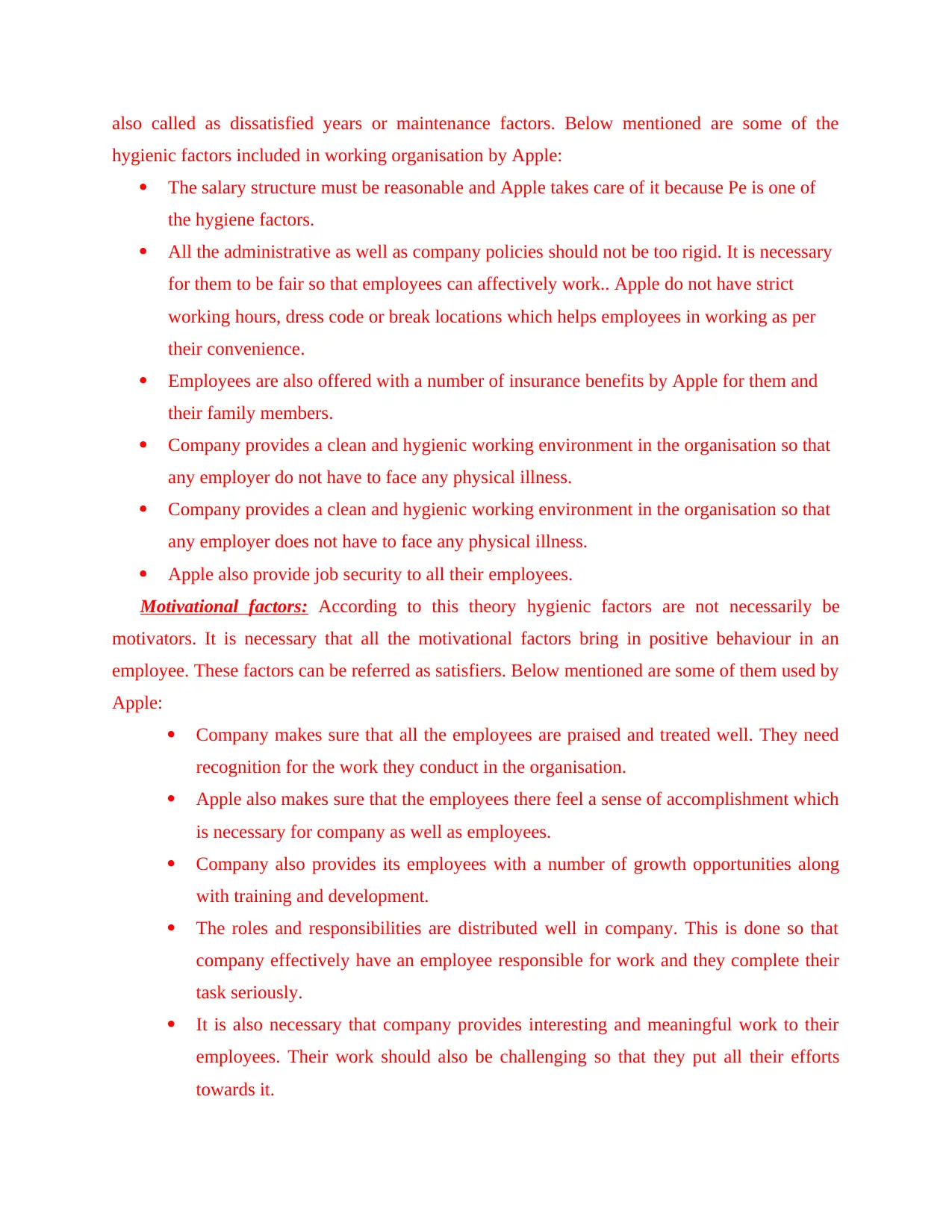
also called as dissatisfied years or maintenance factors. Below mentioned are some of the
hygienic factors included in working organisation by Apple:
The salary structure must be reasonable and Apple takes care of it because Pe is one of
the hygiene factors.
All the administrative as well as company policies should not be too rigid. It is necessary
for them to be fair so that employees can affectively work.. Apple do not have strict
working hours, dress code or break locations which helps employees in working as per
their convenience.
Employees are also offered with a number of insurance benefits by Apple for them and
their family members.
Company provides a clean and hygienic working environment in the organisation so that
any employer do not have to face any physical illness.
Company provides a clean and hygienic working environment in the organisation so that
any employer does not have to face any physical illness.
Apple also provide job security to all their employees.
Motivational factors: According to this theory hygienic factors are not necessarily be
motivators. It is necessary that all the motivational factors bring in positive behaviour in an
employee. These factors can be referred as satisfiers. Below mentioned are some of them used by
Apple:
Company makes sure that all the employees are praised and treated well. They need
recognition for the work they conduct in the organisation.
Apple also makes sure that the employees there feel a sense of accomplishment which
is necessary for company as well as employees.
Company also provides its employees with a number of growth opportunities along
with training and development.
The roles and responsibilities are distributed well in company. This is done so that
company effectively have an employee responsible for work and they complete their
task seriously.
It is also necessary that company provides interesting and meaningful work to their
employees. Their work should also be challenging so that they put all their efforts
towards it.
hygienic factors included in working organisation by Apple:
The salary structure must be reasonable and Apple takes care of it because Pe is one of
the hygiene factors.
All the administrative as well as company policies should not be too rigid. It is necessary
for them to be fair so that employees can affectively work.. Apple do not have strict
working hours, dress code or break locations which helps employees in working as per
their convenience.
Employees are also offered with a number of insurance benefits by Apple for them and
their family members.
Company provides a clean and hygienic working environment in the organisation so that
any employer do not have to face any physical illness.
Company provides a clean and hygienic working environment in the organisation so that
any employer does not have to face any physical illness.
Apple also provide job security to all their employees.
Motivational factors: According to this theory hygienic factors are not necessarily be
motivators. It is necessary that all the motivational factors bring in positive behaviour in an
employee. These factors can be referred as satisfiers. Below mentioned are some of them used by
Apple:
Company makes sure that all the employees are praised and treated well. They need
recognition for the work they conduct in the organisation.
Apple also makes sure that the employees there feel a sense of accomplishment which
is necessary for company as well as employees.
Company also provides its employees with a number of growth opportunities along
with training and development.
The roles and responsibilities are distributed well in company. This is done so that
company effectively have an employee responsible for work and they complete their
task seriously.
It is also necessary that company provides interesting and meaningful work to their
employees. Their work should also be challenging so that they put all their efforts
towards it.
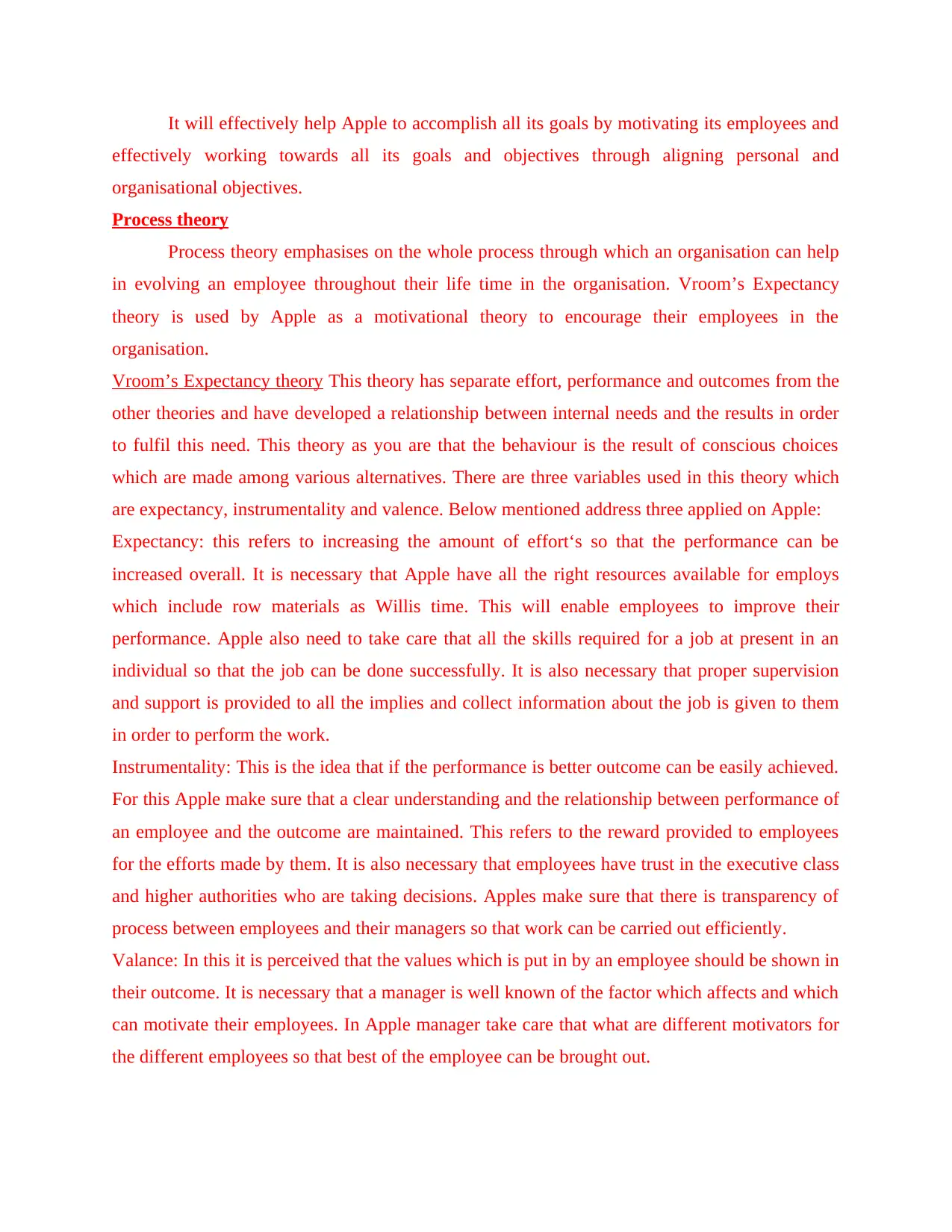
It will effectively help Apple to accomplish all its goals by motivating its employees and
effectively working towards all its goals and objectives through aligning personal and
organisational objectives.
Process theory
Process theory emphasises on the whole process through which an organisation can help
in evolving an employee throughout their life time in the organisation. Vroom’s Expectancy
theory is used by Apple as a motivational theory to encourage their employees in the
organisation.
Vroom’s Expectancy theory This theory has separate effort, performance and outcomes from the
other theories and have developed a relationship between internal needs and the results in order
to fulfil this need. This theory as you are that the behaviour is the result of conscious choices
which are made among various alternatives. There are three variables used in this theory which
are expectancy, instrumentality and valence. Below mentioned address three applied on Apple:
Expectancy: this refers to increasing the amount of effort‘s so that the performance can be
increased overall. It is necessary that Apple have all the right resources available for employs
which include row materials as Willis time. This will enable employees to improve their
performance. Apple also need to take care that all the skills required for a job at present in an
individual so that the job can be done successfully. It is also necessary that proper supervision
and support is provided to all the implies and collect information about the job is given to them
in order to perform the work.
Instrumentality: This is the idea that if the performance is better outcome can be easily achieved.
For this Apple make sure that a clear understanding and the relationship between performance of
an employee and the outcome are maintained. This refers to the reward provided to employees
for the efforts made by them. It is also necessary that employees have trust in the executive class
and higher authorities who are taking decisions. Apples make sure that there is transparency of
process between employees and their managers so that work can be carried out efficiently.
Valance: In this it is perceived that the values which is put in by an employee should be shown in
their outcome. It is necessary that a manager is well known of the factor which affects and which
can motivate their employees. In Apple manager take care that what are different motivators for
the different employees so that best of the employee can be brought out.
effectively working towards all its goals and objectives through aligning personal and
organisational objectives.
Process theory
Process theory emphasises on the whole process through which an organisation can help
in evolving an employee throughout their life time in the organisation. Vroom’s Expectancy
theory is used by Apple as a motivational theory to encourage their employees in the
organisation.
Vroom’s Expectancy theory This theory has separate effort, performance and outcomes from the
other theories and have developed a relationship between internal needs and the results in order
to fulfil this need. This theory as you are that the behaviour is the result of conscious choices
which are made among various alternatives. There are three variables used in this theory which
are expectancy, instrumentality and valence. Below mentioned address three applied on Apple:
Expectancy: this refers to increasing the amount of effort‘s so that the performance can be
increased overall. It is necessary that Apple have all the right resources available for employs
which include row materials as Willis time. This will enable employees to improve their
performance. Apple also need to take care that all the skills required for a job at present in an
individual so that the job can be done successfully. It is also necessary that proper supervision
and support is provided to all the implies and collect information about the job is given to them
in order to perform the work.
Instrumentality: This is the idea that if the performance is better outcome can be easily achieved.
For this Apple make sure that a clear understanding and the relationship between performance of
an employee and the outcome are maintained. This refers to the reward provided to employees
for the efforts made by them. It is also necessary that employees have trust in the executive class
and higher authorities who are taking decisions. Apples make sure that there is transparency of
process between employees and their managers so that work can be carried out efficiently.
Valance: In this it is perceived that the values which is put in by an employee should be shown in
their outcome. It is necessary that a manager is well known of the factor which affects and which
can motivate their employees. In Apple manager take care that what are different motivators for
the different employees so that best of the employee can be brought out.
⊘ This is a preview!⊘
Do you want full access?
Subscribe today to unlock all pages.

Trusted by 1+ million students worldwide
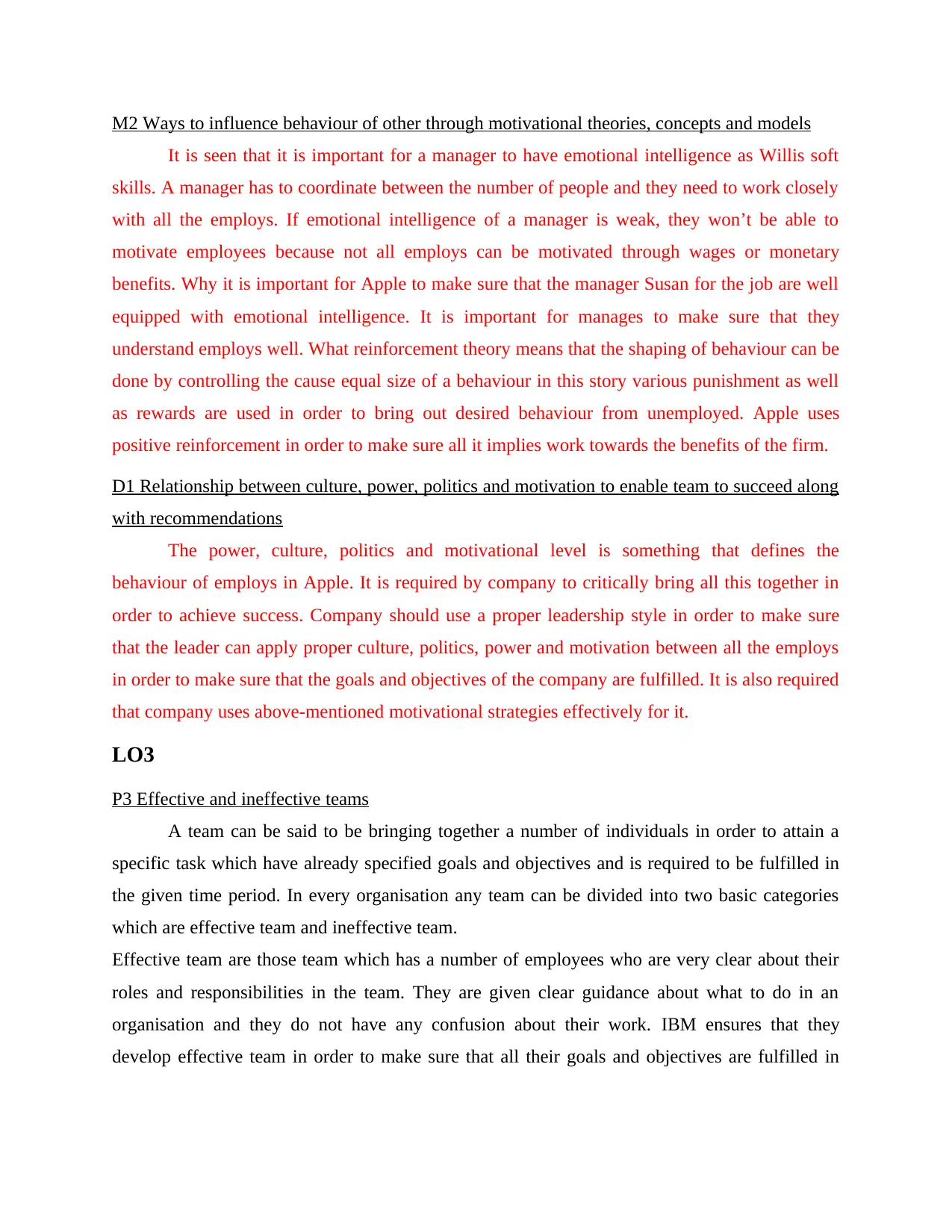
M2 Ways to influence behaviour of other through motivational theories, concepts and models
It is seen that it is important for a manager to have emotional intelligence as Willis soft
skills. A manager has to coordinate between the number of people and they need to work closely
with all the employs. If emotional intelligence of a manager is weak, they won’t be able to
motivate employees because not all employs can be motivated through wages or monetary
benefits. Why it is important for Apple to make sure that the manager Susan for the job are well
equipped with emotional intelligence. It is important for manages to make sure that they
understand employs well. What reinforcement theory means that the shaping of behaviour can be
done by controlling the cause equal size of a behaviour in this story various punishment as well
as rewards are used in order to bring out desired behaviour from unemployed. Apple uses
positive reinforcement in order to make sure all it implies work towards the benefits of the firm.
D1 Relationship between culture, power, politics and motivation to enable team to succeed along
with recommendations
The power, culture, politics and motivational level is something that defines the
behaviour of employs in Apple. It is required by company to critically bring all this together in
order to achieve success. Company should use a proper leadership style in order to make sure
that the leader can apply proper culture, politics, power and motivation between all the employs
in order to make sure that the goals and objectives of the company are fulfilled. It is also required
that company uses above-mentioned motivational strategies effectively for it.
LO3
P3 Effective and ineffective teams
A team can be said to be bringing together a number of individuals in order to attain a
specific task which have already specified goals and objectives and is required to be fulfilled in
the given time period. In every organisation any team can be divided into two basic categories
which are effective team and ineffective team.
Effective team are those team which has a number of employees who are very clear about their
roles and responsibilities in the team. They are given clear guidance about what to do in an
organisation and they do not have any confusion about their work. IBM ensures that they
develop effective team in order to make sure that all their goals and objectives are fulfilled in
It is seen that it is important for a manager to have emotional intelligence as Willis soft
skills. A manager has to coordinate between the number of people and they need to work closely
with all the employs. If emotional intelligence of a manager is weak, they won’t be able to
motivate employees because not all employs can be motivated through wages or monetary
benefits. Why it is important for Apple to make sure that the manager Susan for the job are well
equipped with emotional intelligence. It is important for manages to make sure that they
understand employs well. What reinforcement theory means that the shaping of behaviour can be
done by controlling the cause equal size of a behaviour in this story various punishment as well
as rewards are used in order to bring out desired behaviour from unemployed. Apple uses
positive reinforcement in order to make sure all it implies work towards the benefits of the firm.
D1 Relationship between culture, power, politics and motivation to enable team to succeed along
with recommendations
The power, culture, politics and motivational level is something that defines the
behaviour of employs in Apple. It is required by company to critically bring all this together in
order to achieve success. Company should use a proper leadership style in order to make sure
that the leader can apply proper culture, politics, power and motivation between all the employs
in order to make sure that the goals and objectives of the company are fulfilled. It is also required
that company uses above-mentioned motivational strategies effectively for it.
LO3
P3 Effective and ineffective teams
A team can be said to be bringing together a number of individuals in order to attain a
specific task which have already specified goals and objectives and is required to be fulfilled in
the given time period. In every organisation any team can be divided into two basic categories
which are effective team and ineffective team.
Effective team are those team which has a number of employees who are very clear about their
roles and responsibilities in the team. They are given clear guidance about what to do in an
organisation and they do not have any confusion about their work. IBM ensures that they
develop effective team in order to make sure that all their goals and objectives are fulfilled in
Paraphrase This Document
Need a fresh take? Get an instant paraphrase of this document with our AI Paraphraser
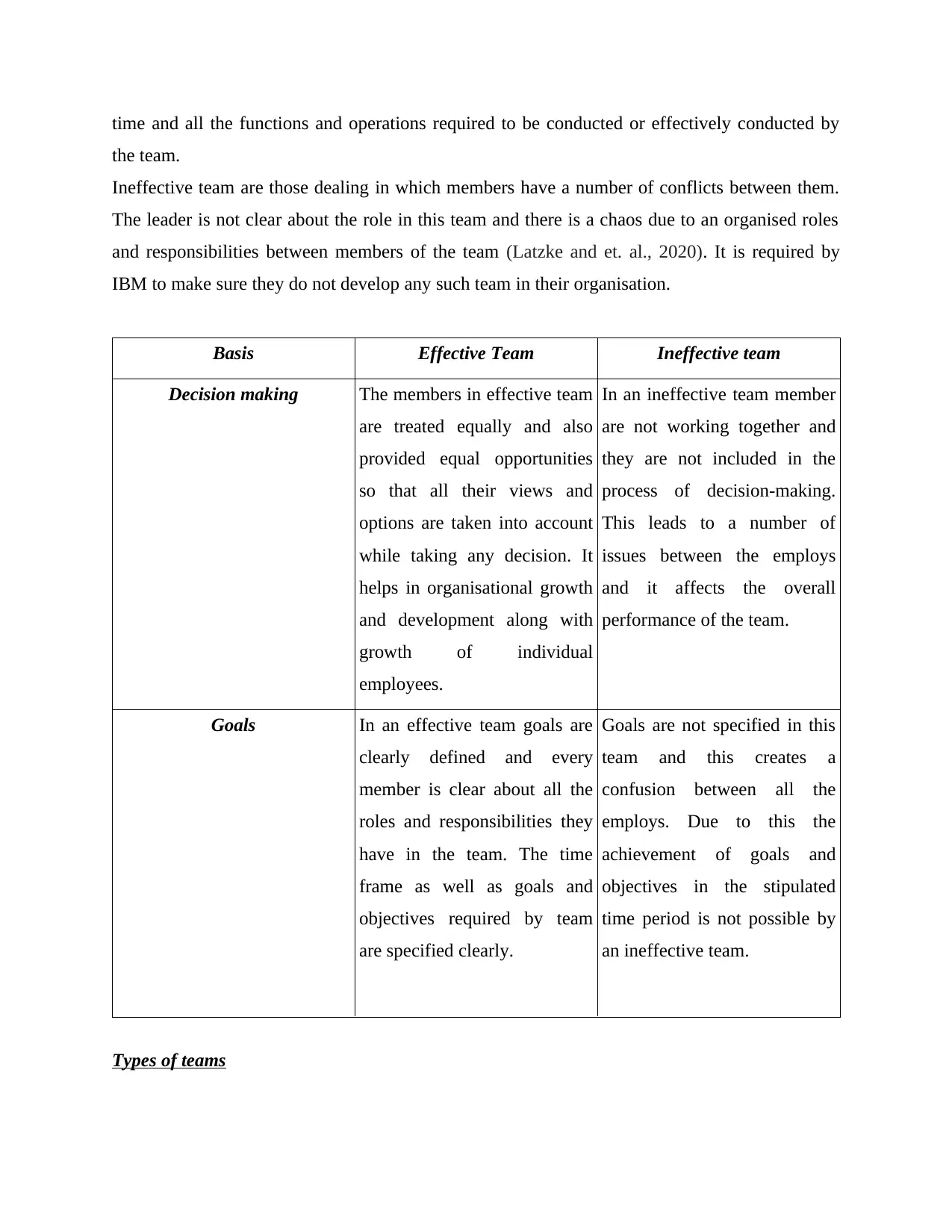
time and all the functions and operations required to be conducted or effectively conducted by
the team.
Ineffective team are those dealing in which members have a number of conflicts between them.
The leader is not clear about the role in this team and there is a chaos due to an organised roles
and responsibilities between members of the team (Latzke and et. al., 2020). It is required by
IBM to make sure they do not develop any such team in their organisation.
Basis Effective Team Ineffective team
Decision making The members in effective team
are treated equally and also
provided equal opportunities
so that all their views and
options are taken into account
while taking any decision. It
helps in organisational growth
and development along with
growth of individual
employees.
In an ineffective team member
are not working together and
they are not included in the
process of decision-making.
This leads to a number of
issues between the employs
and it affects the overall
performance of the team.
Goals In an effective team goals are
clearly defined and every
member is clear about all the
roles and responsibilities they
have in the team. The time
frame as well as goals and
objectives required by team
are specified clearly.
Goals are not specified in this
team and this creates a
confusion between all the
employs. Due to this the
achievement of goals and
objectives in the stipulated
time period is not possible by
an ineffective team.
Types of teams
the team.
Ineffective team are those dealing in which members have a number of conflicts between them.
The leader is not clear about the role in this team and there is a chaos due to an organised roles
and responsibilities between members of the team (Latzke and et. al., 2020). It is required by
IBM to make sure they do not develop any such team in their organisation.
Basis Effective Team Ineffective team
Decision making The members in effective team
are treated equally and also
provided equal opportunities
so that all their views and
options are taken into account
while taking any decision. It
helps in organisational growth
and development along with
growth of individual
employees.
In an ineffective team member
are not working together and
they are not included in the
process of decision-making.
This leads to a number of
issues between the employs
and it affects the overall
performance of the team.
Goals In an effective team goals are
clearly defined and every
member is clear about all the
roles and responsibilities they
have in the team. The time
frame as well as goals and
objectives required by team
are specified clearly.
Goals are not specified in this
team and this creates a
confusion between all the
employs. Due to this the
achievement of goals and
objectives in the stipulated
time period is not possible by
an ineffective team.
Types of teams
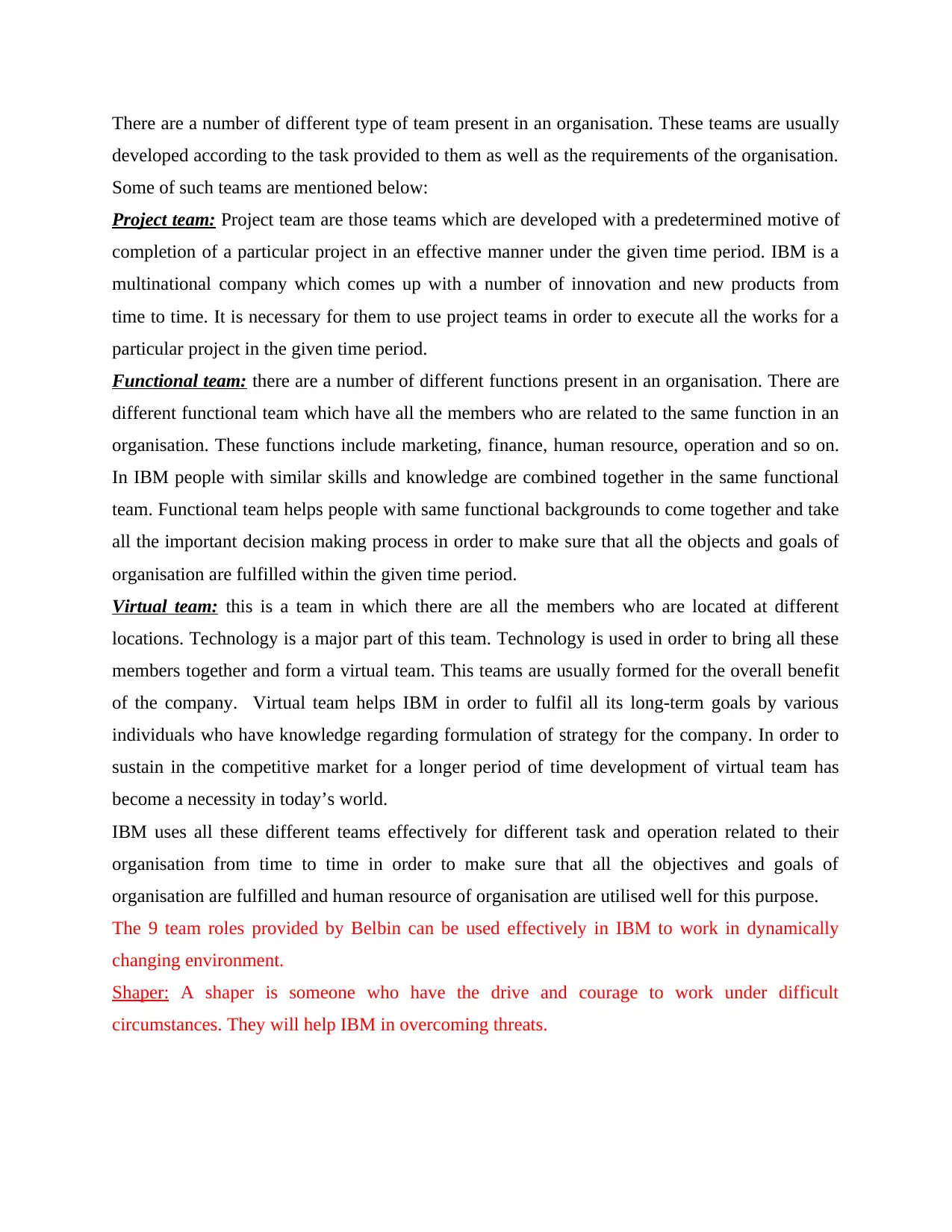
There are a number of different type of team present in an organisation. These teams are usually
developed according to the task provided to them as well as the requirements of the organisation.
Some of such teams are mentioned below:
Project team: Project team are those teams which are developed with a predetermined motive of
completion of a particular project in an effective manner under the given time period. IBM is a
multinational company which comes up with a number of innovation and new products from
time to time. It is necessary for them to use project teams in order to execute all the works for a
particular project in the given time period.
Functional team: there are a number of different functions present in an organisation. There are
different functional team which have all the members who are related to the same function in an
organisation. These functions include marketing, finance, human resource, operation and so on.
In IBM people with similar skills and knowledge are combined together in the same functional
team. Functional team helps people with same functional backgrounds to come together and take
all the important decision making process in order to make sure that all the objects and goals of
organisation are fulfilled within the given time period.
Virtual team: this is a team in which there are all the members who are located at different
locations. Technology is a major part of this team. Technology is used in order to bring all these
members together and form a virtual team. This teams are usually formed for the overall benefit
of the company. Virtual team helps IBM in order to fulfil all its long-term goals by various
individuals who have knowledge regarding formulation of strategy for the company. In order to
sustain in the competitive market for a longer period of time development of virtual team has
become a necessity in today’s world.
IBM uses all these different teams effectively for different task and operation related to their
organisation from time to time in order to make sure that all the objectives and goals of
organisation are fulfilled and human resource of organisation are utilised well for this purpose.
The 9 team roles provided by Belbin can be used effectively in IBM to work in dynamically
changing environment.
Shaper: A shaper is someone who have the drive and courage to work under difficult
circumstances. They will help IBM in overcoming threats.
developed according to the task provided to them as well as the requirements of the organisation.
Some of such teams are mentioned below:
Project team: Project team are those teams which are developed with a predetermined motive of
completion of a particular project in an effective manner under the given time period. IBM is a
multinational company which comes up with a number of innovation and new products from
time to time. It is necessary for them to use project teams in order to execute all the works for a
particular project in the given time period.
Functional team: there are a number of different functions present in an organisation. There are
different functional team which have all the members who are related to the same function in an
organisation. These functions include marketing, finance, human resource, operation and so on.
In IBM people with similar skills and knowledge are combined together in the same functional
team. Functional team helps people with same functional backgrounds to come together and take
all the important decision making process in order to make sure that all the objects and goals of
organisation are fulfilled within the given time period.
Virtual team: this is a team in which there are all the members who are located at different
locations. Technology is a major part of this team. Technology is used in order to bring all these
members together and form a virtual team. This teams are usually formed for the overall benefit
of the company. Virtual team helps IBM in order to fulfil all its long-term goals by various
individuals who have knowledge regarding formulation of strategy for the company. In order to
sustain in the competitive market for a longer period of time development of virtual team has
become a necessity in today’s world.
IBM uses all these different teams effectively for different task and operation related to their
organisation from time to time in order to make sure that all the objectives and goals of
organisation are fulfilled and human resource of organisation are utilised well for this purpose.
The 9 team roles provided by Belbin can be used effectively in IBM to work in dynamically
changing environment.
Shaper: A shaper is someone who have the drive and courage to work under difficult
circumstances. They will help IBM in overcoming threats.
⊘ This is a preview!⊘
Do you want full access?
Subscribe today to unlock all pages.

Trusted by 1+ million students worldwide
1 out of 19
Related Documents
Your All-in-One AI-Powered Toolkit for Academic Success.
+13062052269
info@desklib.com
Available 24*7 on WhatsApp / Email
![[object Object]](/_next/static/media/star-bottom.7253800d.svg)
Unlock your academic potential
Copyright © 2020–2025 A2Z Services. All Rights Reserved. Developed and managed by ZUCOL.





